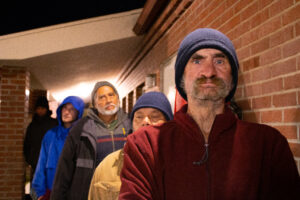
Volunteers were greater in numbers with members of the Lutheran Church handing out blankets and checking people in. The biggest change, however, is the staff added to the payroll. Last year’s warming center typically only had one nightly paid personnel (excluding security.) This led to difficult and expensive 12-hour shifts. But, thanks to funding, the warming center is now able to keep at least two paid staff, splitting the long night in half and reducing the likelihood of overtime.
And they haven’t hired just anyone. They have employed former homeless and people who have stayed at the warming center over the years. People like Hector Gonzalez and Mike Clevenger, who live dramatically different lives from their time on the streets. One particularly notable character is Eric Draven, 36, better known as “Viper.”
At first glance, one could imagine why he was given such a venomous nickname. Tall and intimidating, Viper was previously a drug dealer on the streets of Visalia. When he wasn’t selling drugs, he was getting high or spending time behind bars. But these days Viper has a more virtuous nature. He lives for the warming center and the people it serves. His experience on the streets has been a valuable resource to the staff and some even attribute the warming center’s early success to him.
After local law enforcement began to recognize his positive shift, word spread to the point that even Visalia Mayor Bob Link personally met with Viper to praise his impactful change. But Viper, always mindful of his past, was quick to shift the praise. He emphasized multiple times that if it wasn’t for the warming center, he would likely still be on the streets. More importantly, he used his own story to debunk the stigma surrounding the homeless and to highlight the power of purpose.
“This is my joy for the whole year,” Viper said. “I get three months where I’m needed as a human being…For those who believe the homeless don’t have value, this is proof that they can be put in positions of leadership.”
Christy Bergen, head coordinator for the warming center, is in charge of scheduling volunteers and staff like Viper. She’s confident in the warming center’s ability to serve through this season, stating that they have a “pretty tight running ship”.
This confidence comes after experience gained from the previous two seasons. Experience that she expects will prove useful once a permanent shelter is created. So despite things running arguably smoother than ever, many working with the warming center have their eyes set on the more permanent shelter.
It’s still unclear when this permanent facility will come to fruition. As mentioned recently at the Visalia Planning Commission meeting, the search for a permanent site was ultimately fruitless because prices were either too high or property managers and corporate leadership refused to allow their real estate be used as a homeless shelter.
According to Suzy Ward, pastor at St. Paul’s Episcopal Church and creator of the warming center, even if a permanent shelter is found there’s still a question of funding and sustainability.
“I have money to do this again next year for a short period of time. But okay, what do we do after that? By then hopefully we’ll have a permanent place. But what I get can run a place for 3-4 months, it can’t run a place for 12 months.”
To put it in perspective, other counties with permanent shelters have a budget of around a million dollars. Most of it comes from fundraising with some help from the county. Ward is running her operation on a fraction of that, with little to no financial help from local jurisdictions. If Ward does manage to find a permanent facility, it’s going to take more than just a few grants to keep the place running. She believes both the county and the city will have to pitch in to keep the operation going.
Ward emphasized that this permanent shelter would not only allow them to reach a greater population of the homeless, but also create an environment where all the agencies and services that have been partnering with the warming center over the years can come together in one place for a consistent and efficient collaboration.
Katie Meador, Executive Director of Family Services, arrived later in the evening to donate snacks and beverages. She described how volunteers from her agency have been providing services to homeless at the warming center through supportive housing opportunities and domestic abuse protection. Her agency is one of many partnering with the warming center.
Agencies help homeless like Ralph Solis find housing. Solis is staying at the warming center this season while his wife and son stay at a boarding house. He was recently approved for Section 8 housing and is currently waiting to hear if his family will be housed by early January. Solis and his family are not only on the verge of finding housing, but they’re also receiving other services like frequent psychological counseling, therapy, and treatment.
It’s not uncommon for individual cases, like the Solis family, to be complex. They often require needs beyond just finding employment and housing. And more people are becoming homeless everyday. Which is why Meador believes a temporary low-barrier shelter isn’t enough.
“Yeah, we’re getting some people off the street. But for every one person we’re getting off the street, two, three, four people are coming into the system. So we need to stop the flow there. We need the prevention piece, housing piece, and a low-barrier shelter year round.”
Until then, the warming center will rely on the generosity of the people. If you’re interested in volunteering your time, contact Christy Bergen at christy.thewarehousevisalia@gmail.com. For donations contact Suzy Ward at suzyvisalia@gmail.com.
